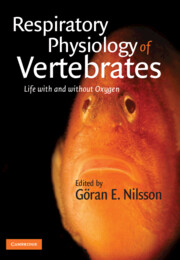Crossref Citations
This Book has been
cited by the following publications. This list is generated based on data provided by Crossref.
Chamberland, Valérie
and
Rioux, Pierre
2010.
Not only students can express alcohol dehydrogenase: goldfish can too!.
Advances in Physiology Education,
Vol. 34,
Issue. 4,
p.
222.
Gardiner, Naomi M.
Munday, Philip L.
Nilsson, Göran E.
and
Romanuk, Tamara Natasha
2010.
Counter-Gradient Variation in Respiratory Performance of Coral Reef Fishes at Elevated Temperatures.
PLoS ONE,
Vol. 5,
Issue. 10,
p.
e13299.
Abele, Doris
Vázquez‐Medina, José Pablo
and
Zenteno‐Savín, Tania
2011.
Oxidative Stress in Aquatic Ecosystems.
p.
1.
Maina, John N.
2011.
Bioengineering Aspects in the Design of Gas Exchangers.
p.
141.
Maina, John N.
2011.
Bioengineering Aspects in the Design of Gas Exchangers.
p.
85.
Metcalfe, J. D.
Le Quesne, W. J. F.
Cheung, W. W. L.
and
Righton, D. A.
2012.
Conservation physiology for applied management of marine fish: an overview with perspectives on the role and value of telemetry.
Philosophical Transactions of the Royal Society B: Biological Sciences,
Vol. 367,
Issue. 1596,
p.
1746.
Madsen, Jesper G.
Wang, Tobias
Beedholm, Kristian
and
Madsen, Peter T.
2013.
Detecting spring after a long winter: coma or slow vigilance in cold, hypoxic turtles?.
Biology Letters,
Vol. 9,
Issue. 6,
p.
20130602.
Bosch-Belmar, Mar
Giomi, Folco
Rinaldi, Alessandro
Mandich, Alberta
Fuentes, Verónica
Mirto, Simone
Sarà, Gianluca
and
Piraino, Stefano
2016.
Concurrent environmental stressors and jellyfish stings impair caged European sea bass (Dicentrarchus labrax) physiological performances.
Scientific Reports,
Vol. 6,
Issue. 1,
Nilsson, Göran E.
and
Lefevre, Sjannie
2016.
Physiological Challenges to Fishes in a Warmer and Acidified Future.
Physiology,
Vol. 31,
Issue. 6,
p.
409.
Townhill, B. L.
Pinnegar, J. K.
Righton, D. A.
and
Metcalfe, J. D.
2017.
Fisheries, low oxygen and climate change: how much do we really know?.
Journal of Fish Biology,
Vol. 90,
Issue. 3,
p.
723.
Williams, Tegan A.
Bergstrome, Jillian C.
Scott, Juliana
and
Bernier, Nicholas J.
2017.
CRF and urocortin 3 protect the heart from hypoxia/reoxygenation-induced apoptosis in zebrafish.
American Journal of Physiology-Regulatory, Integrative and Comparative Physiology,
Vol. 313,
Issue. 2,
p.
R91.
Bigman, Jennifer S.
Pardo, Sebastián A.
Prinzing, Tanya S.
Dando, Marc
Wegner, Nicholas C.
and
Dulvy, Nicholas K.
2018.
Ecological lifestyles and the scaling of shark gill surface area.
Journal of Morphology,
Vol. 279,
Issue. 12,
p.
1716.
Lefevre, Sjannie
McKenzie, David J.
and
Nilsson, Göran E.
2018.
In modelling effects of global warming, invalid assumptions lead to unrealistic projections.
Global Change Biology,
Vol. 24,
Issue. 2,
p.
553.
Geller, Benjamin D.
Gouvea, Julia
Dreyfus, Benjamin W.
Sawtelle, Vashti
Turpen, Chandra
and
Redish, Edward F.
2019.
Bridging the gaps: How students seek disciplinary coherence in introductory physics for life science.
Physical Review Physics Education Research,
Vol. 15,
Issue. 2,
Gallo, Natalya D.
Levin, Lisa A.
Beckwith, Maryanne
and
Barry, James P.
2019.
Home sweet suboxic home: remarkable hypoxia tolerance in two demersal fish species in the Gulf of California.
Ecology,
Vol. 100,
Issue. 3,
Gallo, Natalya D.
Hardy, Kevin
Wegner, Nicholas C.
Nicoll, Ashley
Yang, Haleigh
and
Levin, Lisa A.
2020.
Characterizing deepwater oxygen variability and seafloor community responses using a novel autonomous lander.
Biogeosciences,
Vol. 17,
Issue. 14,
p.
3943.
Gupta, Varun
Jagadev, Preeti
and
Giri, Lalat Indu
2021.
Thermal Nostril Tracking Using YOLOv4-Tiny.
p.
1.
Sampaio‐Pinto, Vasco
Janssen, Jasmijn
Chirico, Nino
Serra, Margarida
Alves, Paula M.
Doevendans, Pieter A.
Voets, Ilja K.
Sluijter, Joost P. G.
van Laake, Linda W.
and
van Mil, Alain
2021.
A Roadmap to Cardiac Tissue‐Engineered Construct Preservation: Insights from Cells, Tissues, and Organs.
Advanced Materials,
Vol. 33,
Issue. 27,
Bigman, Jennifer S.
M’Gonigle, Leithen K.
Wegner, Nicholas C.
and
Dulvy, Nicholas K.
2021.
Respiratory capacity is twice as important as temperature in explaining patterns of metabolic rate across the vertebrate tree of life.
Science Advances,
Vol. 7,
Issue. 19,
Wang, Xue-Ping
Balchak, Deidra M
Gentilcore, Clayton
Clark, Nathan L
and
Kashlan, Ossama B
2022.
Activation by cleavage of the epithelial Na+ channel α and γ subunits independently coevolved with the vertebrate terrestrial migration.
eLife,
Vol. 11,
Issue. ,





